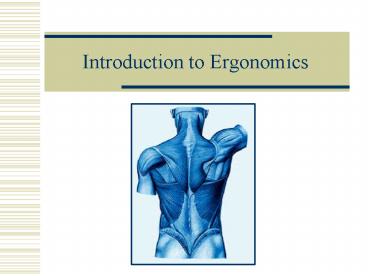Introduction to Ergonomics PowerPoint PPT Presentation
1 / 27
Title: Introduction to Ergonomics
1
Introduction to Ergonomics
2
Engineering
- Definitions
- Process
Problem symptom or need
Problem Definition, Statement of Desired Outcome
Analysis (Experimentation?)
Synthesis of Alternative Solutions
Decision (Selection)
3
Process Example
- What are the design considerations for a
prosthetic Leg?
4
Ergonomics - Introduction
- Derived from the Greek nomos natural laws,
ergon work - Definition discipline that uses knowledge of
human abilities to design systems, jobs, tools,
and products for the safe and efficient execution
of work. - Ergonomic Objective
- Worker Capacity lt Job Demands
5
Ergonomics - Introduction
- Worker Capacity lt Job Demands
- Methods
- Workplace and Equipment Design
- Tool Design
- Design of Work Methods
- Matching Capabilities and Limitations of Worker
6
Ergonomics Introduction
- Why Important?
- Specialization / Automation
- Diversity of Workforce / Labor Laws
- Gender
- Aging Population
- Injured, Disabled workers
- Increase Productivity / Competitive Advantage
- Prevent Injury / Reduce workers Comp Costs
- Societal Quality of Life
7
Ergonomics and Physiology
- Relevant Subject Areas
- Muscular
- Nervous
- Circulatory
- Digestive
- Psychosocial
- Cognitive
- Sensory
8
Ergonomics and Physics
- Force
- Regularly exerted ON the body and BY the body
- Fma
- Acts in a linear direction
- Muscles generate force
9
Ergonomics and Physics
- Torque
- MFD
- Acts as a moment about a fixed point
- Muscles in conjunction with tendons, joins, and
ligaments generate torque.
10
Ergonomics and Physics
- Pressure
- Imparted BY the body and ON the body
- PF/A
- Examples
11
Occupational Injury
- Difference between Ergonomics and Safety?
- Cumulative Trauma Disorders (CTD)
- Definition Bodily injury associated with
repeated biomechanical stress over time.
12
Occupational Injury
- Risk Factors for Cumulative Trauma Disorders
13
Cumulative Trauma Disorders
- Bursitis
- Tendonitis
- Tenosynovitis
- Tendon injury involving the synovial sheath,
caused when excessive amounts of synovial fluid
are created due to extreme repetition. Sheath
becomes swollen or painful.
14
Cumulative Trauma Disorders
- De Quervains Disease
- Tenosynovitis in the tendons at the base of the
thumb. - Finkelstein Test
15
Cumulative Trauma Disorders
- Trigger Finger (Flexor Tendonitis)
- Tendon swelling interferes with the normal
movement of the tendons through the synovial
sheath and can cause the finger to click, catch,
or lock in position
16
Cumulative Trauma Disorders
- Carpal Tunnel Syndrome
- Impaired nervous function in the first three
digits manifested as numbness, tingling, pain,
and loss of dexterity. - Median nerve inside the wrist becomes compressed
due to inflammation or thickening of adjacent
tendon sheaths. Inflammation may be caused by
overexertion or repeated unsafe wrist
orientations.
17
Tool Design Guidelines
- Improper Tool Design May Cause
- Increased grip forces (CTD)
- Unwanted postures (CTD)
- Acute Trauma (Burns, cuts, lacerations,
abrasions, fractures, strains, sprains,
dislocations, etc.) - Reduced Productivity
18
Tool Design Guidelines
- Situations to avoid
- Sustained Ulnar/Radial Wrist deviation
- Excessive or repeated flexion/extension of hand
and wrist - Excessive force
- Impact shocks
- Tissue compression from sharp edges or
misdirected forces - Ischemia obstruction of blood flow to the
tissues and eventual numbness or tingling
19
Tool Design Guidelines
- Types of Grip
- Power
- Precision
- Design for Population
- Gender
- Left/Right Handedness
20
(No Transcript)
21
Tool Design Guidelines
- Handle
- Diameter
- Length
- Shape
- Surface (material)
- Angulation
- Grip Span
- Weight
22
Examples
- Pliers
- Knives
- Scissors
23
(No Transcript)
24
(No Transcript)
25
(No Transcript)
26
Engineering Design Constraints
- Example The Vibration Dilemma
27
The Future
- Workplace and Equipment Design

